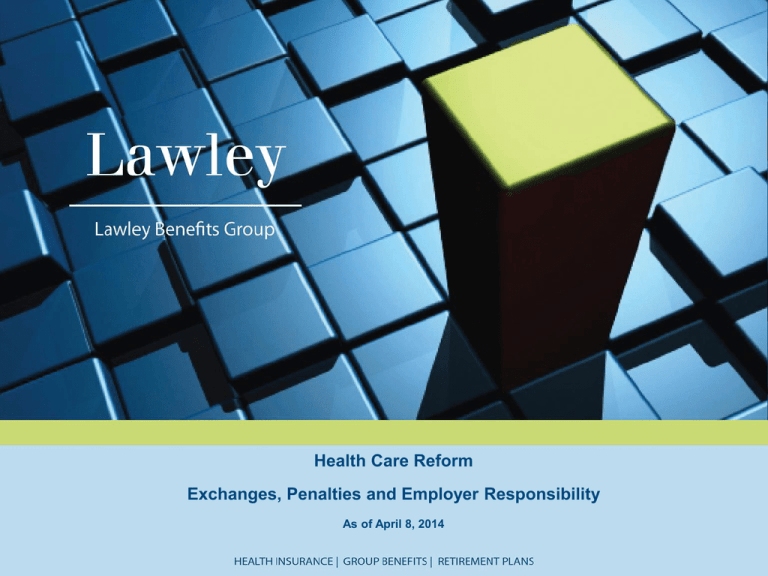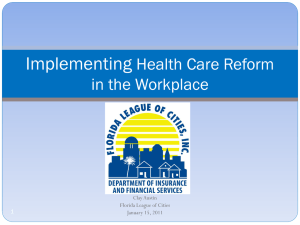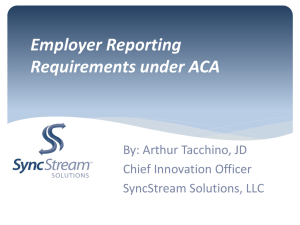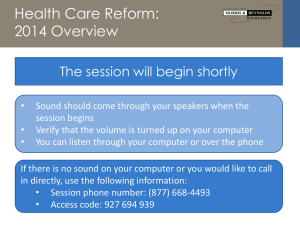Health Care Reform Exchanges, Penalties and
advertisement

Health Care Reform Exchanges, Penalties and Employer Responsibility As of April 8, 2014 Table of Contents Exchanges Determining Large Employer Status Employer Penalty Coverage Requirements Determining Full Time Eligibility Notices and Reporting Taxes and Fees Pages 3-5 Pages 6-7 Pages 8-10 Pages 11-13 Pages 14-20 Page 21-22 Pages 23-26 2 Health Insurance Marketplaces/Exchanges • State-based competitive marketplaces to purchase health insurance and qualify for premium tax credits and cost-sharing reductions. • 2014 open enrollment closed March 31, 2014 • 2015 open enrollment runs November 15, 2014 – February 15, 2015 • Individuals can purchase insurance through a Marketplace if they: • live in its service area, and • are a U.S. citizen or national, or • are a non-citizen who is lawfully present in the U.S. for the entire period for which enrollment is sought • Not incarcerated • Residents of a U.S. territory aren’t eligible to apply for health insurance using the federal or state Marketplace 3 Health Insurance Marketplaces/Exchanges Premium Tax Credits • Tax credits available in connection with Marketplace coverage for taxpayers who: Have household income up to 400% of the Federal Poverty Line (FPL) May not be claimed as a tax dependent of another taxpayer Must file a joint return, if married Are not eligible for minimum essential coverage – including governmentsponsored programs and eligible employer-sponsored plans that provide minimum value and are considered affordable • Cost of self-only employer coverage > 9.56% of employee’s household income = unaffordable for purpose of tax credit • Amount of tax credit is the difference between the cost of the second lowest silver qualified health plan and the expected contribution of the individual based on household income 4 2014 Federal Poverty Guidelines • 48 Contiguous States and DC Household Size 100% 133% 150% 200% 300% 400% 1 $11,670 $15,521 $17,505 $23,340 $35,010 $46,680 2 $15,730 $20,921 $23,595 $31,460 $47,190 $62,290 3 $19,790 $26,321 $29,685 $39,580 $59,370 $79,160 4 $23,850 $31,721 $35,775 $47,700 $71,550 $95,400 5 $27,910 $37,120 $41,865 $55,820 $83,730 $111,640 6 $31,970 $42,520 $47,955 $63,940 $95,910 $127,880 7 $36,030 $47,920 $54,045 $72,060 $108,090 $144,120 8 $40,090 $53,320 $60,135 $80,180 $120,270 $160,360 5 Determining Large Employer Status Applicable Large Employer – employed an average of 50 FT (including FTE) employees on business days during preceding calendar year Full-time employee defined as 30+ hours per week Calculate the total number of full-time employees by adding together: • Full-time employees (averaged 30 hours per week or 130 hours per month), plus • Full-time equivalent employees (total of all hours for part-time employees for the month divided by 120 Example Company has 40 FT employees and 65 PT employees working 20 hours/week: 65 PT x 86 hours each per month = 5,590 / 120 = 46 FTEs 40 FT + 46 FTE = 86 Total FT employees 6 Determining Large Employer Status Controlled Group Rules For purposes of counting the number of FT and FTE employees to determine if applicable large employer, all employees of a controlled group or an affiliated service group are taken into account as a whole For purposes of determining liability for and amount of assessable penalty, each commonly owned/controlled employer within a corporate group is assessed and pays its own penalties separately (even if less than 50) 7 Employer Penalty Large Employer Penalty Trigger ***Assessment of penalty delayed one year until 2016 for employers with less than 100 FT employees*** Applicable large employer may be subject to penalty if either of the following apply: • Employer does NOT offer minimum essential coverage to at least 95% (70% in 2015) of its FT employees (and dependent children) and at least one FT employee receives premium tax credit through Exchange, - OR • Employer offers minimum essential coverage to at least 95% (70% in 2015) of its FT employees (and dependent children) and at least one FT employee receives premium tax credit through Exchange, because • Employer coverage does not provide minimum value (60%), or • Employer coverage is considered unaffordable (> 9.56% household income) to the employee 8 Employer Penalty - NOT Offering Coverage Employer does not offer minimum essential coverage to at least 95% (70% in 2015) of full-time employees (and dependent children) AND At least one full-time employee receives a premium tax credit from the Exchange Annual penalty is: • Number of full-time employees (minus 30) X $2,000 • (minus 80 in 2015) Example Company has 100 full-time employees 100 – 30 = 70 x $2,000 = $140,000 • 100 – 80 = 20 x $2,000 = $40,000 in 2015 9 Employer Penalty - Offering Coverage Employer offers minimum essential coverage to at least 95% (70% in 2015) of fulltime employees AND At least one full-time employee receives a premium tax credit from the Exchange (because coverage is unaffordable or does not provide minimum value) Annual penalty is the lesser of: •$3,000 for each full-time employee who receives a premium tax credit, or •Number full-time employees (minus 30) x $2,000 • (minus 80 in 2015) Example - Company has 500 full-time employees, where 40 receive premium tax credit through the Exchange 40 x $3,000 = $120,000 500 – 30 = 470 x $2,000 = $940,000 Penalty = $120,000 10 Coverage Requirements Minimum Value Employer Coverage • The plan’s share of total allowed costs of benefits provided under the plan is at least 60% of those costs (i.e. 60% actuarial value) • Methods to determine value: – Minimum Value Calculator – Design-Based Safe Harbor Checklists (no need for calculations or actuary) – Actuarial Certification 11 Coverage Requirements Affordable Employer Coverage 9.5% Safe Harbors (in lieu of household income) Based on self-only coverage of lowest cost plan • W-2, Box 1 wages • Rate of Pay Salaried employees = monthly salary Hourly employees = employee’s hourly rate of pay times 130 hours per month • Federal Poverty Line $92.39/month based on 2014 FPL of $11,670/year 12 Coverage Requirements Affordable Employer Coverage Example: • Employer makes 70% contribution towards single premium for HDHP with $2,000 single deductible • Total premium cost is $317.50 per month • Employee contribution is $95.25 per month • All salaries above $12,031 would meet the 9.5% affordability test 13 Determining Full Time Eligibility Hours of Service 30 hours of service per week = 130 hours of service per calendar month Includes: • each hour for which an employee is paid, or entitled to payment, for the performance of duties for the employer: and • Each hour for which and employee is paid, or entitled to payment by the employer on account of a period of time during which no duties are performed due to vacation, holiday, illness, incapacity (including disability), layoff, jury duty, military duty or leave of absence 14 Determining Full Time Eligibility Ongoing (current) Variable Hour Employee – current employee who has been employed for at least one complete Standard Measurement Period • Standard Measurement Period – 3-12 consecutive calendar months – Period used to count/measure hours of service • Stability Period – Minimum 6 months – not shorter than measurement period – Period employee considered PT or FT based on outcome of measurement period • Administrative Period – Up to 90 days – Period after measurement and before stability period – Used to determine status, communicate and enroll 15 Measurement Period for Ongoing Variable Hour Employee Standard Stability Period 1/1/2015 – 12/31/2015 Standard Measurement Period 10/3/2013 – 10/2/2014 Administrative Period 10/3/2014 – 12/31/2014 • 12 Month Standard Measurement Period • 90 Day Administrative Period • 12 Month Standard Stability Period • If employee averages full -time status during Standard Measurement Period, must be treated as full-time and offered coverage for entire Standard Stability Period, regardless of hours worked during Standard Stability Period • If employee averages part-time status during Standard Measurement Period, can treat employee as part-time for entire Standard Stability Period, regardless of hours worked and will not incur a penalty if coverage is not offered. Cannot be longer than measurement period • Standard Measurement Periods run consecutively each year 16 Determining Full Time Eligibility New Variable Hour/Seasonal Employee • • • • • When hired, cannot reasonably be determined if employee will average at least 30 hours per week (including per diem, occasional, on call) Seasonal defined as customarily working 6 months or less per year, same time of year (does not include employees of educational organizations) Initial Measurement Period – 3-12 consecutive calendar months – No penalty assessed during initial measurement period – Must re-test during first standard measurement period Stability Period – Minimum 6 months – not shorter than measurement period Administrative Period – When combined with the initial measurement period, cannot extend past last day of 13th month after hire date 17 Measurement Period for New Variable Hour Employee Administrative Period 6/1/2015 – 6/30/2015 1/1/2015 1/1/2014 1/1/2016 Initial Measurement Period 6/1/2014 – 5/31/2015 1/1/2017 Initial Stability Period 7/1/2015 – 6/30/2016 • Hire date May 10, 2014 • 12 month Initial Measurement Period beginning first of month following date of hire (June 1, 2014) • Administrative Period plus Initial Measurement Period cannot extend beyond the end of the 13 th month after date of hire • 12 month Initial Stability Period • If new hire averages full -time status during Initial Measurement Period, must be treated as full-time and offered coverage for entire Initial Stability Period, regardless of hours worked during Initial Stability Period • If new hire averages part-time status during Initial Measurement Period, not required to offer coverage for the Initial Stability Period. Cannot be longer than measurement period plus one month. 18 New Variable Hour Transition to Ongoing Variable Hour Standard Measurement Period 10/3/2014 – 10/2/2015 Initial Measurement Period 6/1/14-5/31/15 Initial Stability Period 7/1/15-6/30/16 Standard Stability Period 1/1/2016 – 12/31/2016 Administrative Period 10/3/2015 – 12/31/2015 • Hire Date May 10, 2014 • New hire must be tested separately during the first Standard Measurement Period beginning after date of hire, in addition to Initial Measurement Period • Initial Stability Period and Standard Stability Period overlap • If new hire averages full -time status during Standard Measurement Period, must be treated as full-time and offered coverage for entire Standard Stability Period, even if new hire didn’t average full-time during Initial Measurement Period • If new hire averages part-time status during Standard Measurement Period, can treat employee as part-time for the portion of the Standard Stability Period remaining after the Initial Stability Period ends 19 Determining Full Time Eligibility New Full-Time Employee • Any employee who as of the date of hire, is reasonably expected to be employed on average at least 30 hours per week and who is not a “seasonal” or “variable hour” employee • Full-time employees in this category must be offered coverage that becomes effective within 90 days of hire. 20 Notices • Summary of Benefits and Coverage (SBC) • Exchange Notice • Notice of Patient Protections • Statement of Grandfathered Plan, if applicable 21 Employer Information Reporting – Code 6056 • • • • Applicable Large Employer (50+) Due to IRS February 28, 2016 for 2015 calendar year Due to FT employee by January 31, 2016 for 2015 calendar year Form 1094-C transmittal, Form 1095-C employee statement Standard Report • Identify each FT employee and details of coverage offered or elected for each calendar month Simplified Report • Do not need to report monthly details if “qualifying offer” made for all 12 months • Minimum value, 9.5% FPL employee contribution, spouse and children Combined Report • Self-insured plans – additional reporting requirement under Code 6055 22 Taxes and Fees Comparative Effectiveness Research Fees • Plan Years ending after October 1, 2012 through 2019 $1 per covered life per year, for plan years ending on or after 10/1/12 $2 per covered life per year, for plan years ending on or after 10/1/13 Indexed to national health expenditure until 2019 when expires Insured plans paid by the carrier/Self-insured plans paid by the plan sponsor HRA and certain FSA paid by plan sponsor if not integrated with other self-insured plan (count only one life per participant) Paid annually by July 31 via IRS form 720 (quarterly federal excise tax return) 23 Taxes and Fees Transitional Reinsurance Program • • To help stabilize premiums for coverage in individual market $12 Billion for 2014, $8 Billion for 2015, $5 Billion for 2016 The 2014 fee of $63.00 per covered life is due to be paid in 2015 and is payable in two installments: $52.50 in January 2015 and $10.50 in the fourth quarter of 2015. The 2015 fee of $44.00 per covered life is due to be paid in 2016 and is payable in two installments: $33.00 in January 2016 and $11.00 in the fourth quarter of 2016. The 2016 fee amount has yet to be determined. Based on enrollment data submitted to HHS by November 15 Insured plans paid by the carrier/Self-insured plans paid by the plan/employer TPA can be used to remit contributions Self Insured/self administered plans exempt for 2015 & 2016 benefit years HSAs, FSAs, HRA integrated with other health coverage, retiree HRA, and selfinsured plans limited to Rx benefits excluded 24 Taxes and Fees Annual Fee on Health Insurers • Begins in 2014 • Self-Funded Plans are exempt • Standalone dental/vision included • $8 billion 2014, $11.3 billion 2015 & 2016, $13.9 billion 2017, $14.3 billion 2018 • Indexed based on premium growth in future • Each carriers fee will be determined based on their percentage of total premium paid nationally 25 Taxes and Fees Excise Tax on High-Cost Health Plans (Cadillac Tax) •2018 – An excise tax will be charged on high cost plans • Single: $10,200 / Family: $27,500 • 40% Tax on premium that exceeds thresholds above • Includes medical, prescription, HRA, FSA and HSA • Example: Single Plan Annual Premium in 2018 is $12,000 ($12,000 - $10,200 = $1,800 x .40 = $720) • Calculated and reported by employer • Prorated amount paid by coverage provider (fully insured) and employer/plan administrator (self insured) 26 Thank You.








